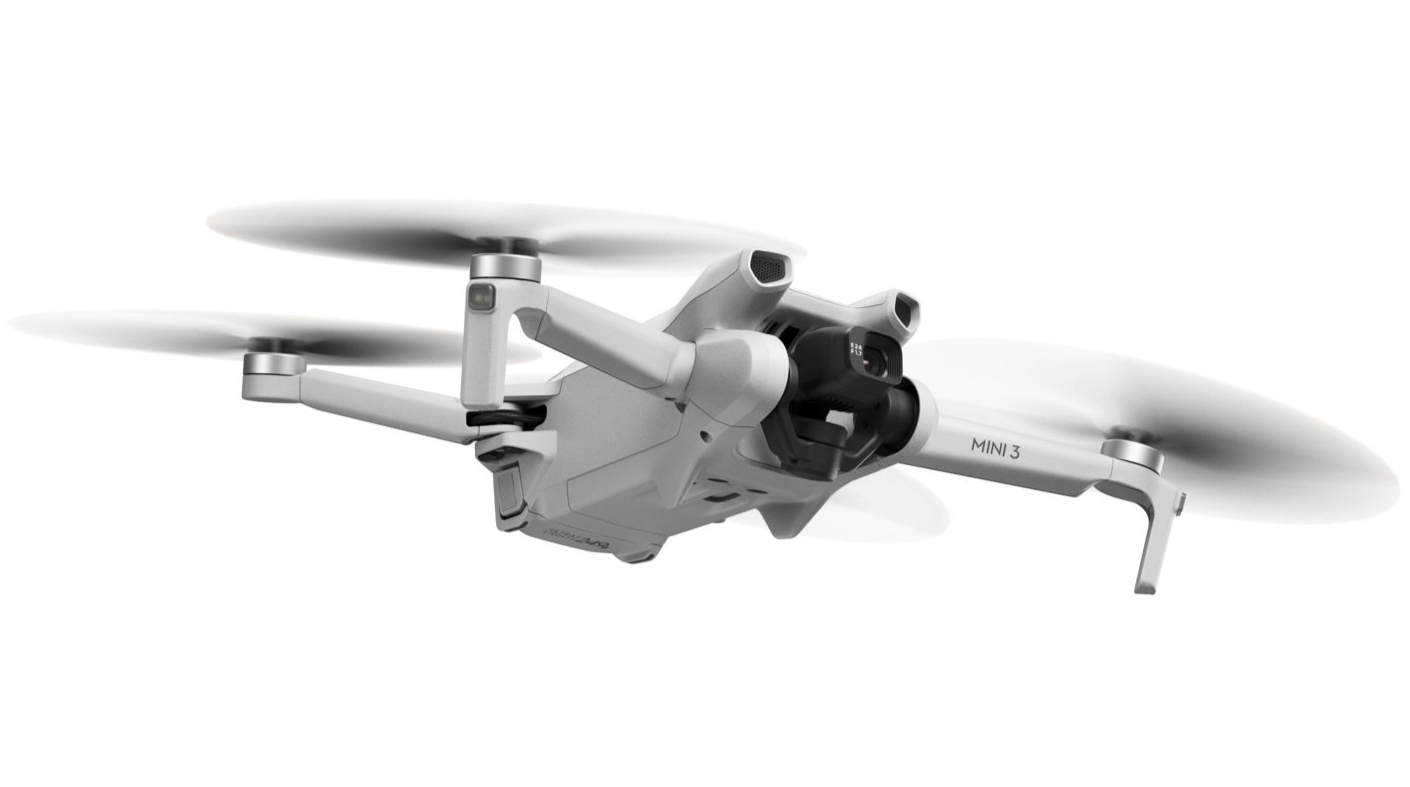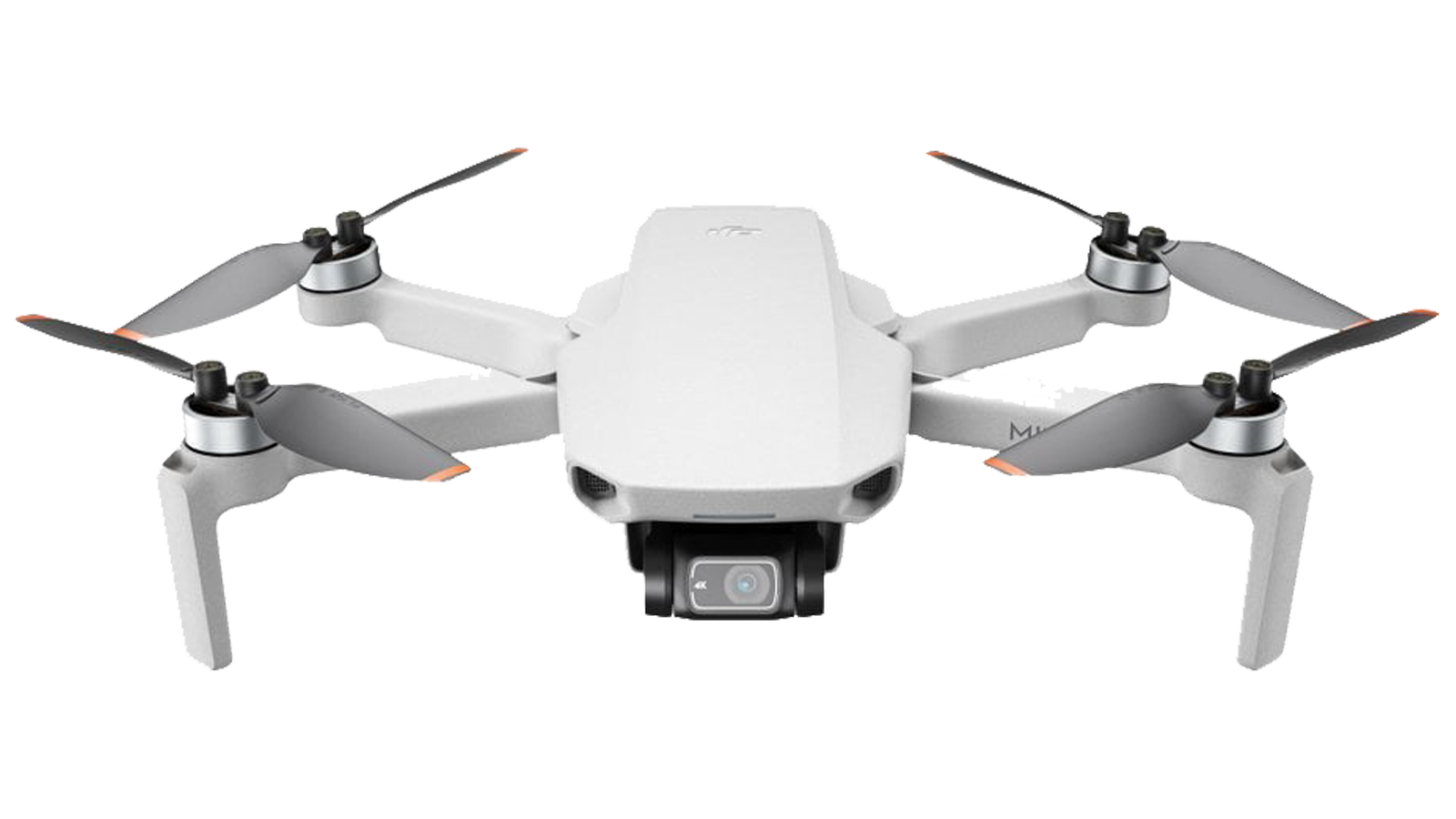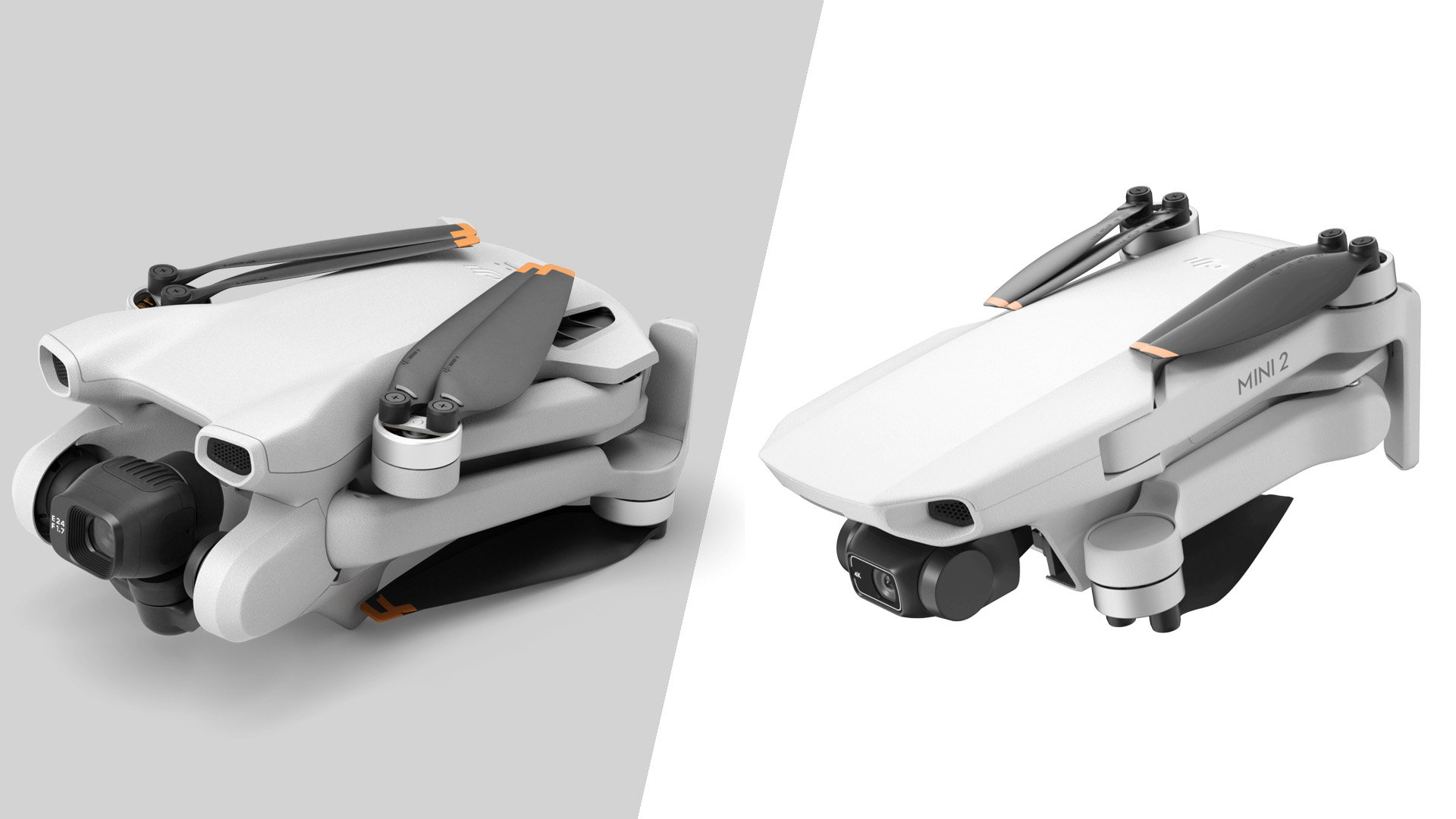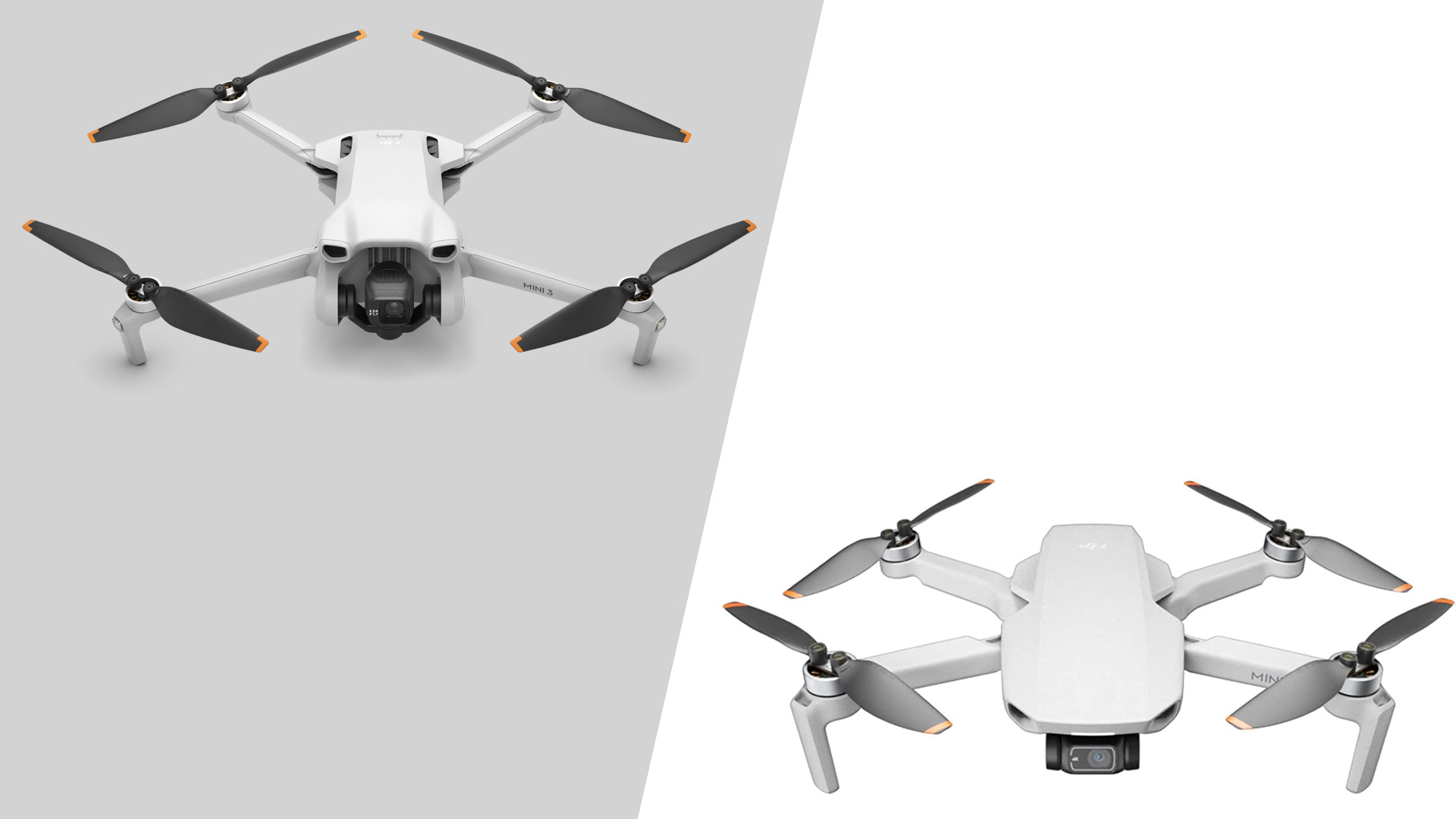DJI Mini 3 vs DJI Mini 2: does the new mini drone live up to its predecessor?
Does the newer DJI compact drone hold up?

Sensor: 48MP 1/1.3-inch CMOS
Video: 4K/60p, 2.7K/60p, 1080/120p
Transmission: OcuSync 2.0
Flight time: 38 mins
The Mini 3 is a mash-up of the pricier DJI Mini 3 Pro and the older DJI Mini 2, and like those drones, its sub-250g weight makes it exempt from drone regulations in many regions. The DJI Mini 3 is, however, a big step up from the Mini 2, thanks to its larger sensor, vertical video powers, longer 38-minute flight time and compatibility with DJI's new RC controller.
Pros
- Better in low-light settings
- Longer flight time
- Portrait mode
Cons
- OcuSync 2.0 connectivity
- Feels snubbed by DJI Mini 3 Pro
- No obstacle-avoidance sensors

Sensor: 12.1MP 1/2.3-inch
Video: 4K/30p, 1080/60p
Transmission: OcuSync 2.0
Flight time: 31 mins
The older DJI Mini 2 remains our pick for drone beginners, due to its more affordable price tag and helpful automated flight modes. Despite its smaller sensor, it shoots high-quality 4K video in good light and has a comparable 31-minute flight time. The lack of obstacle avoidance sensors makes it more vulnerable to crashes, though.
Pros
- Cheaper of the two
- Similar automated modes
- Same compact size
Cons
- Smaller sensor of the two
- No 'follow me' mode
- OcuSync 2.0 connectivity
The DJI Mini 3 is a drone designed to be approachable, and yet able to capture professional-looking results.
Advancements over the DJI Mini 2 include a new camera sensor and lens, and longer flying time per charge. This also comes with a notable rise in price, which means some beginners may want to hunt down a DJI Mini 2 deal while they are still available.
The two drones are also going to feel fairly similar to use, because unlike a high-end drone with an advanced sensor system the DJI Mini 3 only has downward-facing sensors. This rules out more advanced automated routing modes, as without the right sensors the drone can’t tell if it’s about to careen into a tree.
For those, you’ll want the DJI Mini 3 Pro. However, as the cheaper alternative, the DJI Mini 3 seems a well-balanced update to 2020’s Mini 2.
DJI Mini 3 vs DJI Mini 2: price
The DJI Mini 3 costs significantly more than the DJI Mini 2, but DJI has found a way to partially hide that fact for those looking to upgrade from the old model.
It sells the drone with no remote or charger for $469 / £439 / AU$699. This is fairly similar to the original $449 / £419 / AU$749 cost of the DJI Mini 2. However, this jumps to $699 / £669 / AU$1,019 when you add a remote control.
| Row 0 - Cell 0 | DJI Mini 3 | DJI Mini 2 |
| With standard controller | $699 / £669 / AU$1,019 | $450 / £420 / AU$750 |
| With Fly More Combo | $559 / £678 / AU$829 | $599 / £549 / AU$949 |
The Fly More Combo, which includes a bag, charging hub, and two additional batteries, costs $559 / £678 / AU$829, to the $599 / £549 / AU$949 of the old model.
Sign up for breaking news, reviews, opinion, top tech deals, and more.
You may also be able to find Mini 2 packages for less online, now the successor is out.
DJI Mini 3 vs DJI Mini 2: design and controller
- Both weigh under 250g
- Mini 3 is slightly larger than Mini 2
- Mini 3 doesn't get the most out of DJI RC
DJI has not simply taken the Mini 2 shell and updated some of the components. While there is a family resemblance, the Mini 3 is clearly a new design that has been reworked in several key areas.
This was likely necessary anyway, in order to keep the weight below 250g while altering some core components.
Taking a look at the two shells, you might notice the DJI Mini 2 now has what looks like light sensors on the front legs. And the housing to the left and right of the camera gimbal is more built-up.
The DJI Mini 3 ends up a little larger in every dimension when folded up, but it’s unlikely to matter much unless you own a DJI Mini 2 and a very tight-fitting case. A DJI Mini 3 measures 148×90×62 mm folded, to 138x81x58mm in the last generation.

Supported remotes differ in a greater way. The DJI Mini 2 and 3 can both use the standard RC-N1 remote, which doesn't have a built-in display or a clamp to hold your phone. Naturally, packages are available for both drones that include this remote.
Only the DJI Mini 3 supports the DJI RC with a 5.5-inch HD screen and brightness of up to 700 nits. Depending on what model phone you have, this may be brighter. Still, it means you don't need to clamp up your mobile each time you use your drone.
The Mini 3 can’t make full use of the DJI RC’s capabilities, though, as its transmission standard can only manage a 720p, 30fps preview where the remote itself supports up to 1080p, 60 frames per second.
DJI Mini 3 vs DJI Mini 2: specs and features
- DJI Mini 3 has a longer flight time - drastically more with the Plus battery
- The Mini 2 is just as fast as the Mini 3
- Both use the same O2 wireless transmission
Battery life is one of the DJI Mini 3’s key benefits over the older Mini 2. It can fly for up to 38 minutes, compared to 31 minutes in the older drone, using the standard battery. That figure increases to 51 minutes with the Intelligent Flight Battery Plus cell.
This Plus battery is only available in a limited number of regions, however, thanks to the classification system countries use — it will push the drone above 250g, which makes it a pretty big no-no.
DJI has increased flight time by 22%, but battery capacity is only 9% higher — 2453mah to 2250mah — suggesting it has also managed to make significant efficiency improvements elsewhere.

This doesn’t translate to higher speeds, though. Both drones are rated for 16 m/s horizontal speed, 5m/s ascent, and 3.5m/s descent.
They also share the same O2 wireless transmission system, which can communicate with the controller at distances of up to 10km. This depends on where you use the drone, but it’s 10km in the US.
There’s also no boost to the smarts of the sensory system. The DJI Mini 2 and Mini 3 only have downward-facing sensors, not the front and back sensors used in the Mini 3 Pro. This limits the kind of automations that are possible. Both base mini models lack the MasterShots modes of the Pro, which are pro-looking automated programs.
DJI Mini 3 vs DJI Mini 2: image and video quality
- Larger sensor and wider lens aperture grant better native light sensitivity
- True vertical shooting and HDR video in the Mini 3
- Mini 3 has a more versatile gimbal system
DJI has made big changes to both the camera and gimbal system in the Mini 3.
The DJI Mini 2 has a 12MP camera sensor, the Mini 3’s is much larger and 48MP. It’s a 1/1.3-inch sensor, to the 1/2.3-inch style of the Mini 2, and the lens aperture widens from f/2.8 to f/1.7.
Higher native light sensitivity across the sensor and lens means the Mini 3 will hold up better than the Mini 2 at dusk and night. Video is likely to retain its colors better, have superior detail integrity, and generally look a bit less mushy.
We can say this with a degree of confidence because the DJI Mini 3 Pro has the same specs. DJI hasn’t told us the exact sensor used here in the Mini 3, but we’d be willing to bet it’s exactly the same hardware as the Pro.
The DJI Mini 3 gains another important feature we saw in the Pro; “true vertical shooting”. This means the camera can shoot in the same portrait aspect ratio you’re likely to use for certain social media posts.
To get that portrait look in a DJI Mini 2 you’d have to dramatically crop into the footage in the edit.

The DJI Mini 3’s gimbal system is more versatile across another axis too. It tilts between -90 degrees and +60 degrees, compared to -90 to +20 degrees in the Mini 2.
You can also shoot HDR video with the Mini 3. This is only available at frame rates up to 30fps, because it’s sensor-level HDR, just like that of DJI Mini 3 Pro. Two exposures are captured per sensor read-out, which helps avoid ghosting and means this is much more than just a software-based tone mapping profile.
We’re looking at a fairly major upgrade in the DJI Mini 3, but some crucial parts haven’t changed. Both generations of drone tap out at 4K/30 video capture. You need to drop down to 2.7K resolution to hit 60fps.
The Mini 3 Pro can reach 4K resolution at 60fps, suggesting DJI has deliberately limited shooting modes to maintain distance between its models. However, this could also be a processor-related disparity.
Verdict
The DJI Mini 3 is largely just what it should be. It improves upon the DJI Mini 2 with some of the hardware advancements of the Mini 3 Pro, without eating that more professional-oriented Mini 3 Pro’s lunch.
Is it worth upgrading? Quite possibly, particularly if you are hankering for slightly better image quality in lower light or the ability to shoot portrait video to post on social networks.
However, you shouldn’t ignore the DJI Mini 3 Pro if you want to take the quality of your B-roll to the next level. Its more advanced sensor system opens up the kind of looks you can achieve, without much effort, substantially.

Andrew is a freelance journalist and has been writing and editing for some of the UK's top tech and lifestyle publications including TrustedReviews, Stuff, T3, TechRadar, Lifehacker and others.